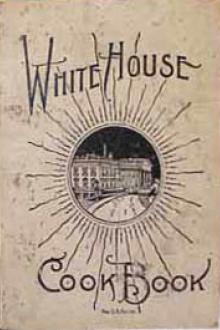The Whitehouse Cookbook (1887), Hugo Ziemann [world of reading .TXT] 📗

- Author: Hugo Ziemann
- Performer: -
Book online «The Whitehouse Cookbook (1887), Hugo Ziemann [world of reading .TXT] 📗». Author Hugo Ziemann
It is a better plan to warm the cream in butter in a separate dish, that the eggs may not have to stand.
EGGS IN CASES.
Make little paper cases of buttered writing paper; put a small piece of butter in each, and a little chopped parsley or onion, pepper and salt. Place the cases upon a gridiron over a moderate fire of bright coals, and when the butter melts, break a fresh egg into each case. Strew in upon them a few seasoned bread crumbs, and when nearly done, glaze the tops with a hot shovel. Serve in the paper cases.
MINCED EGGS.
Chop up four or five hard-boiled eggs; do not mince them too fine. Put over the fire in a suitable dish a cupful of milk, a tablespoonful of butter, salt and pepper, and some savory chopped small. When this comes to a boil stir into it a tablespoonful of flour, dissolved in a little cold milk. When it cooks thick like cream put in the minced eggs. Stir it gently around and around for a few moments and serve, garnished with sippets of toast. Any particular flavor may be given to this dish, such as that of mushrooms, truffles, catsup, essence of shrimps, etc., or some shred anchovy may be added to the mince.
MIXED EGGS AND BACON.
Take a nice rasher of mild bacon; cut it into squares no larger than dice; fry it quickly until nicely browned; but on no account burn it. Break half a dozen eggs into a basin, strain and season them with pepper, add them to the bacon, stir the whole about and, when sufficiently firm, turn it out into a dish. Decorate with hot pickles.
MIXED EGGS GENERALLY—SAVORY OR SWEET.
Much the same method is followed in mixed eggs generally, whatever may be added to them; really it is nothing more than an omelet which is stirred about in the pan while it is being dressed, instead of being allowed to set as a pancake. Chopped tongue, oysters, shrimps, sardines, dried salmon, anchovies, herbs, may be used.
COLD EGGS FOR A PICNIC.
This novel way of preparing cold egg for the lunch-basket fully repays one for the extra time required. Boil hard several eggs, halve them lengthwise; remove the yolks and chop them fine with cold chicken, lamb, veal or any tender, roasted meat; or with bread soaked in milk and any salad, as parsley, onion, celery, the bread being half of the whole; or with grated cheese, a little olive oil, drawn butter, flavored. Fill the cavity in the egg with either of these mixtures, or any similar preparation. Press the halves together, roll twice in beaten egg and bread crumbs, and dip into boiling lard. When the color rises delicately, drain them and they are ready for use.
OMELETS.
In making an omelet, care should be taken that the omelet pan is hot and dry. To insure this, put a small quantity of lard or suet into a clean frying pan, let it simmer a few minutes, then remove it; wipe the pan dry with a towel, and then put in a tablespoonful of butter. The smoothness of the pan is most essential, as the least particle of roughness will cause the omelet to stick. As a general rule, a small omelet can be made more successfully than a large one, it being much better to make two small ones of four eggs each, than to try double the number of eggs in one omelet and fail. Allow one egg to a person in making an omelet and one tablespoonful of milk; this makes an omelet more puffy and tender than one made without milk. Many prefer them without milk.
Omelets are called by the name of what is added to give them flavor, as minced ham, salmon, onions, oysters, etc., beaten up in the eggs in due quantity, which gives as many different kind of omelets.
They are also served over many kinds of thick sauces or purees, such as tomato, spinach, endive, lettuce, celery, etc.
If vegetables are to be added, they should be already cooked, seasoned and hot; place in the centre of the omelet, just before turning; so with mushroom, shrimps, or any cooked ingredients. All omelets should be served the moment they are done, as they harden by standing, and care taken that they do not cook too much.
Sweet omelets are generally used for breakfast or plain desserts.
PLAIN OMELET.
Put a smooth, clean, iron frying pan on the fire to heat; meanwhile, beat four eggs very light, the whites to a stiff froth and the yolks to a thick batter. Add to the yolks four tablespoonfuls of milk, pepper and salt; and, lastly, stir in the whites lightly. Put a piece of butter nearly half the size of an egg into the heated pan; turn it so that it will moisten the entire bottom, taking care that it does not scorch. Just as it begins to boil, pour in the eggs. Hold the frying pan handle in your left hand, and, as the eggs whiten, carefully, with a spoon, draw up lightly from the bottom, letting the raw part run out on the pan, till all be equally cooked; shake with your left hand, till the omelet be free from the pan, then turn with a spoon one half of the omelet over the other; let it remain a moment, but continue shaking, lest it adhere; toss to a warm platter held in the right hand, or lift with a flat, broad shovel; the omelet will be firm around the edge, but creamy and light inside.
MEAT OR FISH OMELETS.
Take cold meat, fish, game or poultry of any kind; remove all skin, sinew, etc., and either cut it small or pound it to a paste in a mortar, together with a proper proportion of spices and salt; then either toss it in a buttered frying pan over a clear fire till it begins to brown and pour beaten eggs upon it, or beat it up with the eggs, or spread it upon them after they have begun to set in the pan. In any case serve hot, with or without a sauce, but garnish with crisp herbs in branches, pickles, or sliced lemon. The right proportion is one tablespoonful of meat to four eggs. A little milk, gravy, water, or white wine, may be advantageously added to the eggs while they are being beaten.
Potted meats make admirable omelets in the above manner.
VEGETABLE OMELET.
Make a purée by mashing up ready-dressed vegetables, together with a little milk, cream or gravy and some seasoning. The most suitable vegetables are cucumbers, artichokes, onions, sorrel, green peas, tomatoes, lentils, mushrooms, asparagus tops, potatoes, truffles or turnips. Prepare some eggs by beating them very light. Pour them into a nice hot frying pan, containing a spoonful of butter; spread the purée upon the upper side; and when perfectly hot, turn or fold the omelet together and serve. Or cold vegetables may be merely chopped small, then tossed in a little butter, and some beaten and seasoned eggs poured over.
OMELET OF HERBS.
Parsley, thyme and sweet marjoram mixed gives the famous omelette aux fines herbes so popular at every wayside inn in the most remote corner of sunny France. An omelet "jardiniere" is two tablespoonfuls of mixed parsley, onion, chives, shallots and a few leaves each of sorrel and chevril, minced fine and stirred into the beaten eggs before cooking. It will take a little more butter to fry it than a plain one.
CHEESE OMELET.
Beat up three eggs, and add to them a tablespoonful of milk and a tablespoonful of grated cheese; add a little more cheese before folding; turn it out on a hot dish; grate a little cheese over it before serving.
ASPARAGUS OMELET.
Boil with a little salt, and until about half cooked, eight or ten stalks of asparagus, and cut the eatable part into rather small pieces; beat the egg and mix the asparagus with them. Make the omelet as above directed. Omelet with parsley is made by adding a little chopped parsley.
TOMATO OMELET. No. 1.
Peel a couple of tomatoes, which split into four pieces; remove the seeds and cut them into small dice; then fry them with a little butter until nearly done, adding salt and pepper. Beat the eggs and mix the tomatoes with them, and make the omelet as usual. Or stew a few tomatoes in the usual way and spread over before folding.
TOMATO OMELET. No. 2.
Cut in slices and place in a stewpan six peeled tomatoes; add a tablespoonful of cold water, a little pepper and salt. When they begin to simmer, break in six eggs, stir well, stirring one way, until the eggs are cooked, but not too hard. Serve warm.
RICE OMELET.
Take a cup of cold boiled rice, turn over it a cupful of warm milk, add a tablespoonful of butter melted, a level teaspoonful of salt, a dash of pepper; mix well, then add three well-beaten eggs. Put a tablespoonful of butter in a hot frying pan, and when it begins to boil pour in the omelet and set the pan in a hot oven. As soon as it is cooked through, fold it double, turn it out on a hot dish, and serve at once. Very good.
HAM OMELET.
Cut raw ham into dice, fry with butter and when cooked enough, turn the beaten egg over it and cook as a plain omelet.
If boiled ham is used, mince it and mix with the egg after they are beaten. Bacon may be used instead of raw ham.
CHICKEN OMELET.
Mince rather fine one cupful of cooked chicken, warm in a teacupful of cream or rich milk a tablespoonful of butter, salt and pepper; thicken with a large tablespoonful of flour. Make a plain omelet, then add this mixture just before turning it over. This is much better than the dry minced chicken. Tongue is equally good.
MUSHROOM OMELET.
Clean a cupful of large button mushrooms, canned ones may be used; cut them into bits. Put into a stewpan an ounce of butter and let it melt; add the mushrooms, a teaspoonful of salt, half a teaspoonful of pepper and half a cupful of cream or milk. Stir in a teaspoonful of flour, dissolved in a little milk or water to thicken, if needed. Boil ten minutes, and set aside until the omelet is ready.
Make a plain omelet the usual way, and just before doubling it, turn the mushrooms over the centre and serve hot.
OYSTER OMELET.
Parboil a dozen oysters in their own liquor, skim them out and let them cool; add them to the beaten eggs, either whole or minced. Cook the same as a plain omelet.
Thicken the liquid with butter rolled in flour; season with salt, cayenne pepper and a teaspoonful of chopped parsley. Chop up the oysters and add to the sauce. Put a few spoonfuls in the centre of the omelet before folding; when dished, pour the remainder of the sauce around it.
FISH OMELET.
Make a plain omelet, and when ready to fold, spread over it fish prepared as follows: Add to a cupful of any kind of cold fish, broken fine, cream enough to moisten it, seasoned with a tablespoonful of butter; then pepper and salt to taste. Warm together.
ONION OMELET.
Make a plain omelet, and when ready to turn spread over it a teaspoonful each of chopped onion and minced parsley; then fold, or, if preferred, mix the minces into





Comments (0)